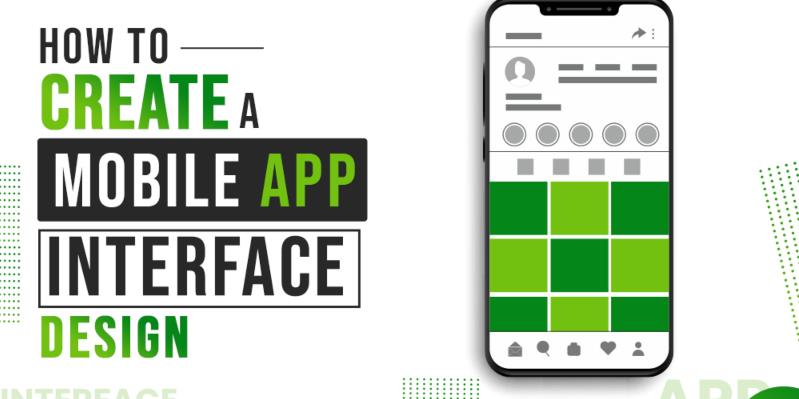How to Create a Mobile App Interface Design
Recall the techniques covered in this guide when you are ready in your next step. Before turning to the computer always start with paper and pencil. The method is going to be easier. Software developers and programmers with gigabytes of expertise have received the rules, tricks, and secrets.
A great UI design keeps you a step ahead in the mobile app development competition. The competition in the development of the apps is very high. Quality of User experience (UX) is typically the difference between good software and a bad application. A good UX is what distinguishes between successful and failing apps. Mobile users today expect a lot from an app: quick loading, comfort, and pleasure during contact. If you're searching for quality in your device, you need to view UX as an essential part of product management rather than just a minor aspect of architecture.
Before you design a mobile app there are multiple things you should consider. Here are a lot of practical recommendations that you can apply to your mobile app design below:
Keep quiet and don't rush into your design:
It’s impossible to conquer the race without having a goal in life, which similarly implies mobile app designs also. You should carry out detailed research before developing the design. Make sure that you don't just research online.
Try to get some ideas from family, friends, and others. Thorough application analysis is needed. Note the points that will revolve around your research:
- Take a look at certain competitive app layout design. The application can even be used and the strengths and weaknesses found. You shouldn’t have your competitors to copy anything. Take something special and unique.
- Target the audience: you have to narrow your attention and collect information on your age, place, preferences, abilities, shortcomings, engagement and hobbies. They're going to use your software, after all.
- When a software design function is delegated to you, answer questions such as "what's the intention of the device" and "what kind of individuals are going to use" etc.
- Always have a map in your mind about what user experiences when he looks at the design. First, the user downloads the app, registers/logs in and then visits the app for quick information and goes to the list of operations and clicks and it continues. It will be simple for you while planning this trip.
- While designing the plan, try to arrange the template so that the code does not tangle. Even, on one interface don't install too many things.
Simply organize the content and decide the user's course:
When you have completed your work and have a plan ahead of you, it becomes simpler and more exciting to get going.
Why are we interested in? Okay, you must realize, as an illustrator, that you have developed the user's picture. However, some users use either iOS or Android platforms.
As a result, all of the paths a user can follow should be provided when he/she sees the app. We can share information on the architecture of the iOS app's user interface:
- Organize the content according to an order. Take, for starters, WhatsApp. Users obtain a number and a security code upon launching the app. In addition, a profile should be created, pictured and the "About" page should be included. WhatsApp synchronizes the contacts next. A chain of actions thus exists.
- Optimize the template so that the device adapts to increasing interface types and handset sizes.
- Please keep in mind the margins for different smartphones operate. If not, certain phones might not show the entire page. Samsung Galaxy S8, for instance, has a screen covering nearly the entire phone, but not iPhone 8.
- Also, you must have been familiar with the changes in pages taken place.
- Also, note the reality that the inhabitants are gone. For everybody, the code must be clear.
You will have a prototype ready for testing in PSD format after all the planning, conception, and development. You can also use an app design tool to create a mock-up. Please keep in mind during the production of certain aspects such as easy navigation or quick touch.
Research- The key to success:
Testing always plays a key part in the success of the app, every major app developer states. At every point of development, you must test the application. This helps you to avoid significant future changes.
Sketch Mirror is, for example, an iOS device creation tool that allows you to evaluation your work. Many device programmers disregard this segment and are not preferred by large companies. The most important points during the test are:
- Take the smallest details, because in stage 4 the little mistake can be the biggest problem.
- Test on various mobile devices with different forms and sizes of screens. You should see to it that the app fits perfectly.
- Without bugs, the software must provide good interaction with the customer.
- It is necessary to monitor the user experience and what issues the consumer may have with the use of special tools if they are on the play store.
- You can use an audit to achieve the outcome of your case.
- There must be reported for future purposes the number of participants who checked the question with some information.
Universal rules on touch:
We never mentioned anything about touch when we talked about the simple, simple design. Touch is an integral part of your user experience.
A normal user must determine how well the app works when it is hit or whether it responds to contact or not. Steven Hoober claims that 7 mm (center), 12 mm (covers) and 9 mm (covers) are the strongest contact standards.
- Rule 1: What you think is different for users. You may try to touch in another manner
- Rule 2: Users always like to click in the middle and see at the center of the screen. There must, therefore, be the most essential navigational components.
- Rule 3: Leave room for the material still. The fingertips of the consumer are not in the center of the product in this manner.
- Rule 4: Individuals are not completely affected. You must have larger buttons and try not to place buttons on the edges.
- Rule 5: Make the request as transparent as possible. It should be recorded, easy to translate, comprehensible and touch-sensitive. That's when the customer tapes the buy button.
Related Posts
A web app development has been ruling the world for a very long time. Customers are eager to invest in web app development as Paws has made things easier for the users.
As the world of eCommerce continues to evolve, businesses are constantly seeking ways to stand out in the digital landscape. According to a report by Statista, it is predicted that global online sales will reach an impressive mark of $6.5 billion by 2023.
The rapidly changing landscape of e-commerce demands businesses to create a compelling online presence. However, establishing a formidable online store demands much more than a mere digital replica of a physical storefront. It requires a deep understanding of human psychology and a strategic...
For startups in 2024, there are few aspects as important as web development.
Recently, stock photos have become a popular choice in design.
With the digital world picking pace and setting high benchmarks for the upcoming ideas in the industry, the upcoming digital decade is likely to experience much improved and robust digital ideas.


















Comments
comments powered by Disqus